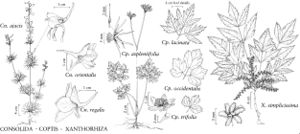Coptis trifolia
Trans. Linn. Soc. London 8:305. 1807.
Rhizomes bright-yellow to orange. Leaves: blade ternate; leaflets sessile or short-petiolulate, blade cuneate-obovate, margins serrate, slightly lobed distally. Inflorescences 1-flowered, usually equal to or longer than leaves at anthesis, 3-17 cm, not elongating in fruit. Flowers erect; sepals spreading, oblanceolate to obovate or elliptic, 4-11× 1-4 mm; petals clavate, nectary apical, blade absent; stamens 30-60. Follicles 4-7; stipe equal to or longer than body; body elliptic, 3.9-7 mm; beak straight to ascending, 2-4 mm. Seeds 1-1.5 mm. 2n=18.
Phenology: Flowering late spring–summer (May–Aug).
Habitat: Wet to mesic, coniferous and mixed forests, bogs, willow scrub, and tundra, often associated with mosses
Elevation: 0-1500m
Distribution

Greenland, St. Pierre and Miquelon, Alta., B.C., Man., N.B., Nfld. and Labr. (Nfld.), N.W.T., N.S., Ont., P.E.I., Que., Sask., Alaska, Conn., Ind., Maine, Md., Mass., Mich., Minn., N.H., N.J., N.Y., Ohio, Pa., R.I., Vt., W.Va., Wis., e Eurasia
Discussion
M.L. Fernald (1929) treated plants from Greenland and eastern North America as Coptis groenlandica and those from Alaska and eastern Asia as C. trifolia. He did concede, however, that intermediates do occur. E.Hultén (1937) treated the two taxa as subspecies but concluded that C. trifolia subsp. trifolia was restricted to the Aleutian Islands in North America. Plants from southeastern Alaska were comparable to material from Greenland and were called C. trifolia subsp. groenlandica. Hultén (1944) later reversed this decision, concluding that the differences between the two subspecies were too slight to warrant their continued recognition. Finally, R. L. Taylor and G. A. Mulligan (1968), in their study of North American Coptis, found that the two subspecies could be distinguished on the basis of sepals and seed shape: subsp. trifolia having clawed petals and quadrate seeds; subsp. groenlandica possessing sepals that gradually narrow toward the base and round seeds.
Petiolule length, sepal width, the length-to-width ratio of the nectary, follicle body and beak length, and sepal and seed shape have been used most commonly to distinguish these two taxa. My comparison of herbarium specimens from the Aleutian Islands, the rest of North America, and eastern Asia indicated that no clear distinction could be made (table 1). Some plants from eastern Asia and the Aleutian Islands had more distinctly clawed sepals than those from eastern North America but this was not evident on all individuals. Seeds from eastern North American plants were found to be variable in shape, with all seeds having at least one angle in cross section.
Native Americans used various preparations made from the roots of Coptis trifolia medicinally to treat stomach cramps, jaundice, sore mouth and throat, gum problems, and worms, to stop vomiting, especially for children, as eyedrops, for teething, and as an astringent (D. E. Moerman 1986).
Tables
Table 1. Morphological comparison of Coptis trifolia from the Aleutian Islands, the rest of North America, and Asia.
| Aleutians | Other N. Amer. | Asia | |
|---|---|---|---|
| Petiolules (mm) | 0.3-0.8 | 0.5-3.5 | 0.5-3 |
| Sepals (mm wide) | 1.7-2.9 | 1-3.6 | 1.8-4.5 |
| Nectaries (L:W ratio) | 0.9-1.3 | 0.8-1.3 | 0.9-1.6 |
| Follicle bodies (mm) | 3.9-5.3 | 4-7 | 4.8-5.5 |
| Follicle beaks (mm) | 3-3.5 | 2.3-3.8 | 2.2-3 |
Selected References
None.
